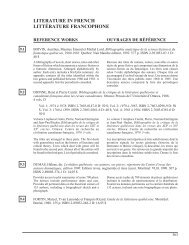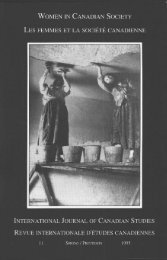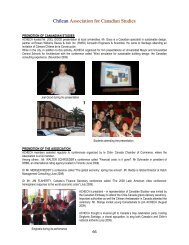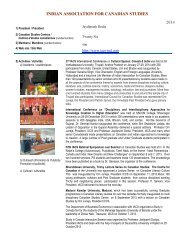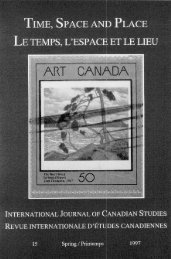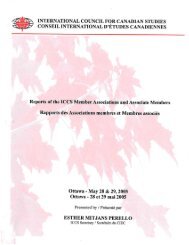Arts and Literature in Canada:Views from Abroad, Les arts et la ...
Arts and Literature in Canada:Views from Abroad, Les arts et la ...
Arts and Literature in Canada:Views from Abroad, Les arts et la ...
- No tags were found...
You also want an ePaper? Increase the reach of your titles
YUMPU automatically turns print PDFs into web optimized ePapers that Google loves.
The Jordans. Remembered <strong>and</strong> Invented Past[...] we would suffer cont<strong>in</strong>uous estrangement <strong>from</strong> ourselves if itweren’t for our memory of the th<strong>in</strong>gs we have done, of the th<strong>in</strong>gs thathave happened to us. If it weren’t for the memory of ourselves.And for the voice that assumes the task of tell<strong>in</strong>g it. (MC, 4)Thus, the protagonist’s pa<strong>in</strong>ful <strong>in</strong>vestigation of her childhood <strong>and</strong> her soci<strong>et</strong>y’scomplicity (the cover-ups <strong>and</strong> silences of the Third Reich as well as of postwarGermany) carries a moral weight that <strong>in</strong>forms the whole novel. Grow<strong>in</strong>gup <strong>in</strong> a small Canadian town <strong>in</strong> the thirties <strong>and</strong> forties is a radically differentexperience. Munro’s protagonist <strong>in</strong> Lives of Girls <strong>and</strong> Women does not have todeal with the moral vicissitudes of a soci<strong>et</strong>y’s guilty <strong>and</strong> oppressive past. How,then, can two novels of such disparate narrative fram<strong>in</strong>g yield a common po<strong>in</strong>tof departure for a comparative study?There is a seem<strong>in</strong>gly trivial d<strong>et</strong>ail, a “r<strong>and</strong>om <strong>in</strong>tersection of alien orbits,” 3 <strong>in</strong>the two novels that <strong>in</strong> itself would not justify a comparative study, but whichstrikes the perceptive reader as an <strong>in</strong>trigu<strong>in</strong>g textual sign: the first-personnarrators of the two novels have strik<strong>in</strong>gly simi<strong>la</strong>r names. Del<strong>la</strong> (Del) Jordanis the name of Munro’s hero<strong>in</strong>e, while Wolf’s protagonist is given the (<strong>from</strong> aGerman po<strong>in</strong>t of view uncharacteristic) name of Nelly Jordan. Simi<strong>la</strong>r firstnames, identical family names <strong>in</strong> two novels written <strong>in</strong> different <strong>la</strong>nguages,stemm<strong>in</strong>g <strong>from</strong> unre<strong>la</strong>ted literary traditions, y<strong>et</strong> published with<strong>in</strong> five years ofeach other by female writers born two years apart 4 —should this curious d<strong>et</strong>ailbe dismissed as a freakish co<strong>in</strong>cidence?The critical approach of <strong>in</strong>tertextuality <strong>and</strong> reader-oriented theories provide amotivation for such a comparison without posit<strong>in</strong>g a direct <strong>in</strong>fluence of onewriter on the other. We may <strong>in</strong>terpr<strong>et</strong> the name Jordan (used as a family name<strong>in</strong> the two novels) as a textual sign “straddl<strong>in</strong>g two texts, two <strong>la</strong>nguages, twocivilizations.” 5 The secondary use of Jordan as a family name po<strong>in</strong>ts to theprimary nam<strong>in</strong>g of the arch<strong>et</strong>ypal river <strong>in</strong> the Bible which, <strong>in</strong> our case, wouldconstitute the <strong>in</strong>tertext. Hav<strong>in</strong>g established this <strong>in</strong>tertextual referentiality, thisunexpected l<strong>in</strong>k b<strong>et</strong>ween two seem<strong>in</strong>gly unre<strong>la</strong>ted texts, an <strong>in</strong>formed readermay well feel motivated to look for further parallels with<strong>in</strong> the novels Lives ofGirls <strong>and</strong> Women <strong>and</strong> K<strong>in</strong>dheitsmuster. Accord<strong>in</strong>g to Stanley Fish, it is the<strong>in</strong>formed reader (possess<strong>in</strong>g both “l<strong>in</strong>guistic” <strong>and</strong> “literary comp<strong>et</strong>ence”) whoproduces an <strong>in</strong>terpr<strong>et</strong>ation of a text’s thematic <strong>and</strong> formal features, e.g. an<strong>in</strong>terpr<strong>et</strong>ation that does not resort to any objective criteria outside the read<strong>in</strong>gexperience. 6 Wolfgang Iser <strong>and</strong> Hans Robert Jauß, the most <strong>in</strong>fluentialrepresentatives of Rezeptionsästh<strong>et</strong>ik (commonly referred to <strong>in</strong> English asreception-theory), provide less radical, more pragmatic tools of <strong>in</strong>terpr<strong>et</strong>ationfor the purposes of this <strong>in</strong>vestigation. Iser’s concept of the “implied reader”<strong>and</strong> Jauß’ term “horizon of expectation” (which will be <strong>in</strong>troduced <strong>in</strong>connection with relevant text material) will prove helpful <strong>in</strong> theor<strong>et</strong>icallyunderp<strong>in</strong>n<strong>in</strong>g the argument of this paper.65



